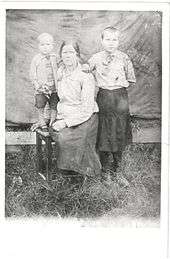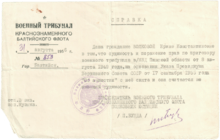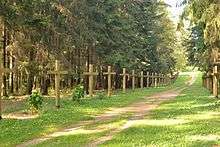Virtual Museum of Soviet Repression in Belarus
The Virtual Museum of Soviet Repression in Belarus (Belarusian: Віртуальны музей савецкіх рэпрэсій у Беларусі) is a non-commercial project of oral history from historians and other scientists from Belarus. Created as a virtual museum, it covers Soviet repression in Belarus.
Background
In 2007, the Belarusian Christian Democracy party launched a campaign called "Repentance". The campaign began meeting with former prisoners of camps, record their memories, and collect materials on the subject of repression.[1]
In 2012, an independent civic initiative was formed, which began to create a Virtual museum of Soviet repression in Belarus. The basis for the museum were materials collected during the campaign "Repentance".
In 2014, a website for the virtual museum was created.[2] The museum is only available online; there is currently no physical exhibition of the material.

Concept of the museum
The museum operates with an approach of oral history by presenting recordings of inhabitants of Belarus who report on their personal experiences with Repression during the Soviet time. By this the museum covers a part of Belarusian history which is mainly excluded from current Belarusian official historiography.[3]

The content of the exhibition consists of recordings of audio- and video-recollections,[4] photos, documents, and statistics connected with repression in Belarus. Also, a chronicle of the repression in Belarus and some historical articles are included.
The museum currently includes seven showrooms:
- Soviet myths
- Chronology of repression
- Victims of repression
- The system of repression
- Anti-Soviet resistance
- Rehabilitation
- Commemorative culture
Amongst the museum's special features are besides the narrative interviews inter alia interactive maps of the NKVD[5] in Belarus, and memorials on repression.[6] In addition the museum offers a victim-search option with more than 30.000 records.[7]
Partners
Among the partners of this project are Konrad Adenauer Foundation and the Belarusian Oral History Archive project.[8]
See also
- Soviet repressions in Belarus
- Kurapaty
- Gulag
- Virtual museum
- Museum of Genocide Victims
- Museum of Soviet Occupation, Kiev
References
- BCD campaign "Repentance" (In Belarusian).
- "Radio Racyja - Internet museum about repressions victims created (in Belarusian)". Retrieved May 24, 2015.
- "Naviny.by - Historian: The theme of Stalin political repression is not reflected in schoolbook either in movies(in Russian)". Retrieved May 25, 2015.
- "Youtube channel of the Virtual Museum of Soviet Repression in Belarus". Retrieved May 24, 2015.
- "Virtual Museum of Soviet Repression in Belarus (in Belarusian)". Retrieved May 24, 2015.
- "Virtual Museum of Soviet Repression in Belarus (in Russian)". Retrieved May 24, 2015.
- "Virtual Museum of Soviet Repression in Belarus (in Belarusian)". Retrieved May 24, 2015.
- "Virtual Museum of Soviet Repression in Belarus (in Belarusian)". Retrieved May 24, 2015.
